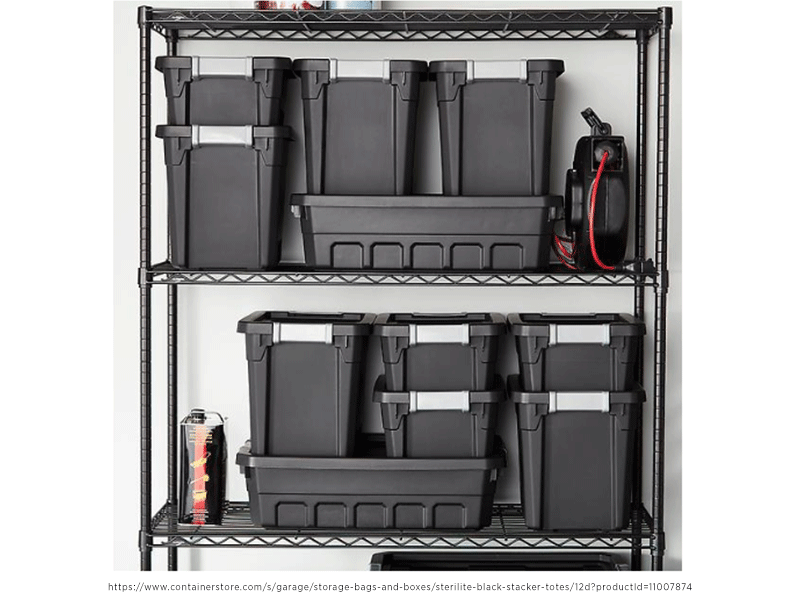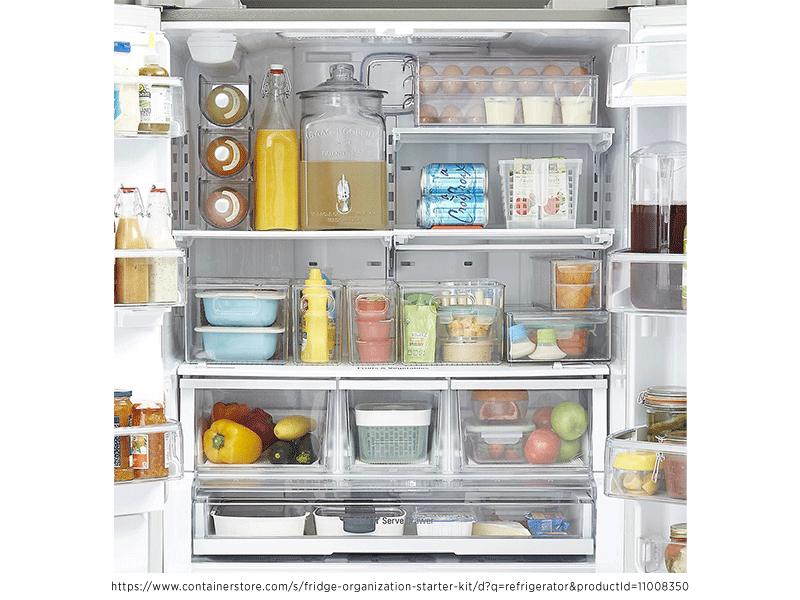Home Storage: A How-To Guide to Help Keep You Organized and Clutter-Free

The importance of staying organized is never more apparent than when you are packing, unpacking, or simply going through a purge. Having a place for everything, and then keeping those places organized and free of clutter, can be cumbersome and a bit overwhelming, but at TNT Moving Systems we have a few tricks to help you keep everything in its right place.
No matter the size of the home, we always find a way to fill it with stuff. It accumulates rather quickly, this stuff: that comfy chair you were given but don’t really need; excess clothing items you’re just not ready to get rid of (what if boot-leg jeans come back into style?); a garage full of lumber for, you know, that treehouse you have been planning on building for the kids—who just left for college.
It’s difficult to get rid of stuff, even when we know we need to do it. But worry not, we are here to help. And the first step in becoming clutter-free is not to look at how much you have, but instead to figure the what and where.
What to Keep & Where to Store it
Before we look into how to store specific items, you need to decide where you will store them. Obviously, dishes and the like go in the kitchen, the sofa and television in the living room, etc. But what about those things you want to keep, but you don’t use all the time?
The first step in organizing your home is to figure out how you are going to work with the space you have. And no matter the size of your home, it’s best to begin with the rule of three. Decide on the three areas of your home that will be most used to store lesser-used items. Typically, these areas include the basement, garage/shed, and attic. Here are some general rules for using each of these three areas for storage:
Basement: for some reason, people love to put boxes and perishables in their basements. This is usually not a good idea because the basement of any house is the first place to flood. Basements are also a bit more humid than the rest of the house, which encourages mold to grow. Now, just because basements tend to take in moisture it doesn’t mean you can’t use this area for storage, you just need to be thoughtful about what you put down there. At TNT Moving Systems, we recommend using a basement to store the following only:
- Plastic furniture (outdoor, children’s, etc.)
- Unused toys
- Kitchen supplies that are sealed and kept in glass or plastic containers
 Garage/Shed: whether or not your garage or shed is insulated, this is a good place to store anything that can withstand extreme hot and cold weather. And even though people like to store food items in the garage, especially when the garage and kitchen are connected or close, this is not a good idea. Insects, reptiles, and even rodents, always find a way in and out, and you don’t want to have anything around that could attract them. However, these things are fine to be stored in a garage or shed:
Garage/Shed: whether or not your garage or shed is insulated, this is a good place to store anything that can withstand extreme hot and cold weather. And even though people like to store food items in the garage, especially when the garage and kitchen are connected or close, this is not a good idea. Insects, reptiles, and even rodents, always find a way in and out, and you don’t want to have anything around that could attract them. However, these things are fine to be stored in a garage or shed:
- Tools
- Outdoor equipment
- Clothing (in sealed bags or containers to keep away from moths and other insects)
- Holiday décor
Attic: unless it is temperature-controlled, an attic can get pretty hot or cool—but not near as much as your garage. This area of the house is the most used for storage, and the biggest problem with using the attic is we usually forget what we put up there! Here are items to be stored way upstairs:
- Decorations
- Suitcases and other luggage items
- Fabrics and furniture
- Miscellaneous items that don’t seem to fit anywhere else in the house
Now that you have those storage items put away, let’s jump into the fun stuff like organizing the refrigerator, silverware drawer, and cabinet area. The very thought of going through these places and purging and organizing induces sweat and calls up that vein protruding from your forehead—but don’t stress! We got you.
The Kitchen
A well-organized kitchen provides more than just food and drink. It creates a warm and welcoming area for conversation and cooking—a place to explore new ideas and establish traditions. And because we use our kitchens so much (at least three times a day, but of course it’s much more than that), we find that the level of organization in which our kitchen is kept, strongly determines how organized we are in our own lives; a dirty, unkempt kitchen makes us feel discombobulated, out of place. But a clean, kept kitchen makes us calm and happy, ready to try new things.
 When we are organized we feel good. We feel right, like we can do anything. So let’s look at organizing three separate areas within the kitchen: the fridge, the silverware drawer, and the upper cabinets (used for housing dishes).
When we are organized we feel good. We feel right, like we can do anything. So let’s look at organizing three separate areas within the kitchen: the fridge, the silverware drawer, and the upper cabinets (used for housing dishes).
- The Fridge: an organized fridge can save you money and time. The first step is to clean out and discard. This means getting rid of those items past their expiration dates (you know you have a jar of pickles sitting in your refrigerator from 2012), and also throwing out those products you know you are never going to use.
The second step is to reorganize the shelves within the fridge. Reconfigure the shelves so that you are able to have the items most used in the front or inside the door. You want everything placed in order of use. This keeps you from having to dig through areas of the fridge for one little thing, which then tips over the milk carton initializing a domino-like collapse of everything else on that shelf.
Next, find a heavy-duty and water-resistant shelf liner (The Container Store makes these specifically for inside the fridge) and line the bottom of all shelving areas. This will make cleanup from rotten fruit or spills much easier. What’s more, if the spillage is too drastic you can remove the liners and wash them.
Now it’s time to fill the fridge back up. Be sure and keep all similar items together—for example mustard, ketchup, and salad dressing can all go together. Consider purchasing small organization bins meant for a fridge (you can find these at The Container Store as well) where items can easily be kept together.
Stack to save space. Certain items, like fruit containers and jars, can be stacked pretty easily, but what about cans or bottles? These are likely to take up the most space because they are so difficult—if not impossible—to stack. But rest assured, there is a way. We love the bottle and can dispenser from…wait for it…The Container Store, which is a small, flat piece of plastic with ridges that keep individual bottles and cans in place and stackable. This is a wonderful way to save space in the fridge.
- The Silverware: it takes all of five seconds for the silverware drawer to become disorganized. Now you and the rest of your family find yourselves rummaging around in it with one hand, creating that always-recognizable song of silverware clinking and chiming like nails running down a chalkboard. And all this just to find a fork. But it doesn’t have to be like this. This is a small organization project that delivers big results.
Begin by taking everything out of the drawer(s) and setting them in groups (spoons with spoons, forks with forks, you get it). Now, go through each group and try and remember the last time that item type was used. If you can’t remember, throw it out!
Next, measure the interior of the drawer and buy a durable liner to place inside (you can find quality liners at Target, The Container Store, even Walmart).
Once the drawer is lined, purchase individual silverware organizers (The Container Store has these made of wood and we find they work well and look the best). The problem with those one-piece plastic organizers is you are stuck with one design. What happens when you add more silverware or need to reconfigure? This is what’s so nice about using individual boxes. Now you can set your silverware drawer up just as you like it. And if you need to add a section for new silverware, just buy another organizer.
- The Cabinets: the upper cabinets are typically reserved for dishes. This area is also one that becomes cluttered quickly, but with a few organization hacks, you can have the cleanest, most organized cabinets in the neighborhood.
Start by taking all the dishes out and placing them somewhere safe. Then measure and place a liner down—be sure to use one with rubber or any other non-slip surface so you know your dishes will stay in place, even when bumped or pushed.
Now, in order to take advantage of all your vertical space, consider using Undershelf brackets and hooks for those wasted spaces above your stacked plates and bowls. Undershelf brackets are perfect for small mugs and saucers because they act as mini shelving areas that attach to the underside (with small screws) of the interior of the cabinet. And hooks can be used for more mugs or anything else with a handle.
Another way to add storage room is by utilizing stackable shelves. By simply placing a stackable shelf inside of your cabinet you can create even more room to stack plates and bowls. It’s a shelf within a shelf and it’s genius!
Organized: A Way of Life
Becoming organized takes some work. For instance, cleaning out and reorganizing a fridge can take up to a day to complete. Working on your silverware drawer and cabinets might not take quite as long, but it’s still a lot of work. But here’s the thing: once you are organized, it’s really not that difficult to remain that way.
Think of it as a way of life, and you will quickly begin to notice the benefits of being organized, because life is better when your home is well put together.
Feel free to contact us at TNT Moving Systems for more organization ideas—what about your dining room or play areas? We’re here to help!
-Andrae Bergeron
*Source: https://www.containerstore.com/organization-projects?search=kitchen&page=1#stq=kitchen&stp=1




